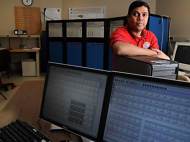Future smart power grids could be run by thinking machines
 Dr. Ganesh Kumar Venayagamoorthy, a power engineering expert at Missouri University of Science and Technology (Missouri S&T), has recently published an article in the latest issue of IEEE’s Smart Grid newsletter where he wrote about plans to develop a smart grid which could autonomously learn and adapt to new situations, from power outages along the grid to fluctuations in the power supply.
Dr. Ganesh Kumar Venayagamoorthy, a power engineering expert at Missouri University of Science and Technology (Missouri S&T), has recently published an article in the latest issue of IEEE’s Smart Grid newsletter where he wrote about plans to develop a smart grid which could autonomously learn and adapt to new situations, from power outages along the grid to fluctuations in the power supply.
Smart grid – a system that uses intelligent computer networks to manage electric power – must take on almost human-like intelligent characteristics, such as the ability to make decisions, adapt to unfamiliar situations, learn from changes in their environments and make sense of how all of the electricity flows through the nation’s power grid.
“And those capabilities, in turn, will depend on subsystems that continuously improve their knowledge of grid dynamics, and not just gather data”, Venayagamoorthy wrote in the article.
Venayagamoorthy examines the current state of Computational intelligence (CI) and adaptive critic designs (ACDs), and discusses that field’s potential to give rise to what he calls Computational Systems Thinking Machines (CSTMs). CI is the successor to Artificial Intelligence (AI) and the way forward in future computing, and ACDs are based on a teacher-student framework in which one part of a computer network (the student) learns from another.
“Several research studies have reported using CI-based technologies to dynamically forecast wind and solar power, monitor voltage stability, and assess real-time stability”, Venayagamoorthy wrote. “In combination, CI and ACD technologies can provide a smart grid with capabilities for dynamic foresight, sense-making, situational awareness, rapid adaptation, fault-tolerance and robustness.”
Unless we witness a major breakthrough in energy generation technology, it is expected that we’re going to become more dependent on currently alternative sources of energy such as wind and solar power. The smart-grid could adjust when the demand for electricity is low, by dispatching power from wind farms to storage units that can store the excess power for later use.
Venayagamoorthy is the founder of Missouri S&T’s Real-Time Power and Intelligent Systems Laboratory and a principal investigator in the Brain2Grid project where living neural networks composed of thousands of brain cells from laboratory rats to control simulated power grids in the lab. From those studies, he hopes to create a “biologically inspired” computer program to manage and control complex power grids.
For more information, you can read the article published in the IEEE’s Smart Grid newsletter named: “Future Grids Will Not Be Controllable Without Thinking Machines”.









Leave your response!